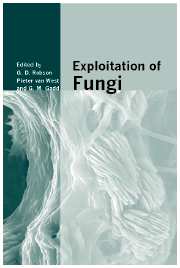Book contents
- Frontmatter
- Contents
- List of contributors
- Preface
- I Comparative and functional fungal genomics
- II Bioactive molecules
- III Protein folding and secretion
- IV Fungal bioremediation
- V Fungal biocontrol of pests
- 14 Fungal control of subterranean pests
- 15 Development of mycoherbicides and evaluation of potential risks (using Stagonospora as a model)
- 16 A novel understanding of the three-way interaction between Trichoderma spp., the colonized plant and fungal pathogens
- 17 Fungal parasites of invertebrates: multimodal biocontrol agents?
- Index
- References
16 - A novel understanding of the three-way interaction between Trichoderma spp., the colonized plant and fungal pathogens
from V - Fungal biocontrol of pests
Published online by Cambridge University Press: 05 October 2013
- Frontmatter
- Contents
- List of contributors
- Preface
- I Comparative and functional fungal genomics
- II Bioactive molecules
- III Protein folding and secretion
- IV Fungal bioremediation
- V Fungal biocontrol of pests
- 14 Fungal control of subterranean pests
- 15 Development of mycoherbicides and evaluation of potential risks (using Stagonospora as a model)
- 16 A novel understanding of the three-way interaction between Trichoderma spp., the colonized plant and fungal pathogens
- 17 Fungal parasites of invertebrates: multimodal biocontrol agents?
- Index
- References
Summary
Abstract
Trichoderma-based biofungicides are a reality in agriculture, with more than 50 formulations available today as registered products worldwide. Several strategies have been applied to identify the main genes and compounds involved in this complex cross-talk between the fungal antagonist and the microbial pathogen, as mediated by the plant. Proteome and genome analysis have greatly enhanced our ability to conduct holistic and genome-based functional studies. We have identified and determined the role of a variety of novel genes and gene-products, including ABC transporters, enzymes and other proteins that produce or act as novel elicitors of induced systemic resistance, proteins recognized by the plant as avirulence factors, as well as molecules that generally activate the antagonistic activity in Trichoderma spp. We have cloned mycoparasitism-related promoters and used them in combination with GFP and other markers to study the interaction in vivo and in situ between Trichoderma and the fungal pathogen or the plant. Finally, we have transgenically improved the ability of the antagonist to kill other microbes and to activate plant defence mechanisms.
Introduction
Plant diseases caused by pathogenic fungi infections represent a major limiting factor for the cultivation and the conservation of agricultural plants of interest. The consequences of parasite attack result in both quantitative and qualitative reduction of crop production, large economic losses and represent a risk for human and animal health due to the accumulation of residues in the environment and mycotoxin contaminants in food products.
- Type
- Chapter
- Information
- Exploitation of Fungi , pp. 291 - 309Publisher: Cambridge University PressPrint publication year: 2007
References
- 1
- Cited by

